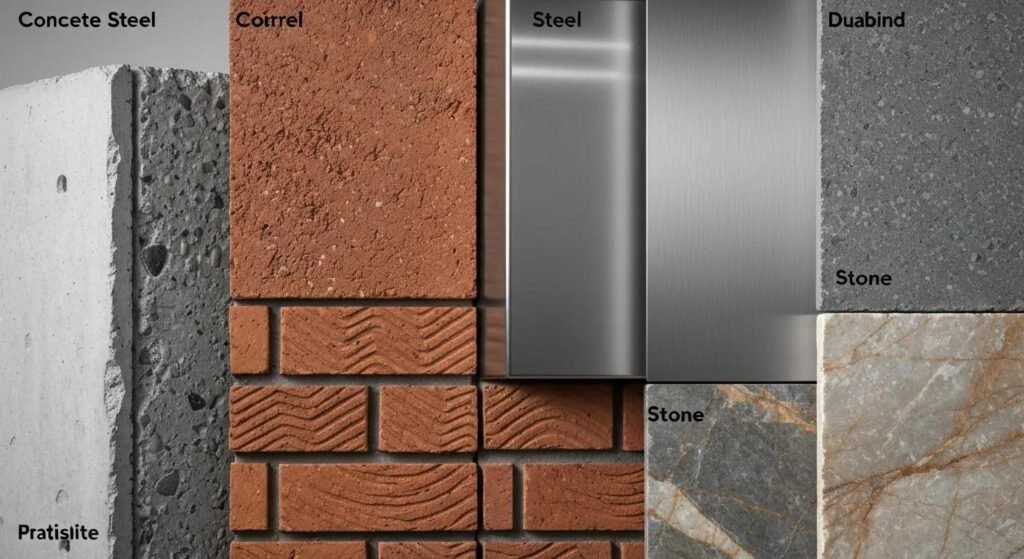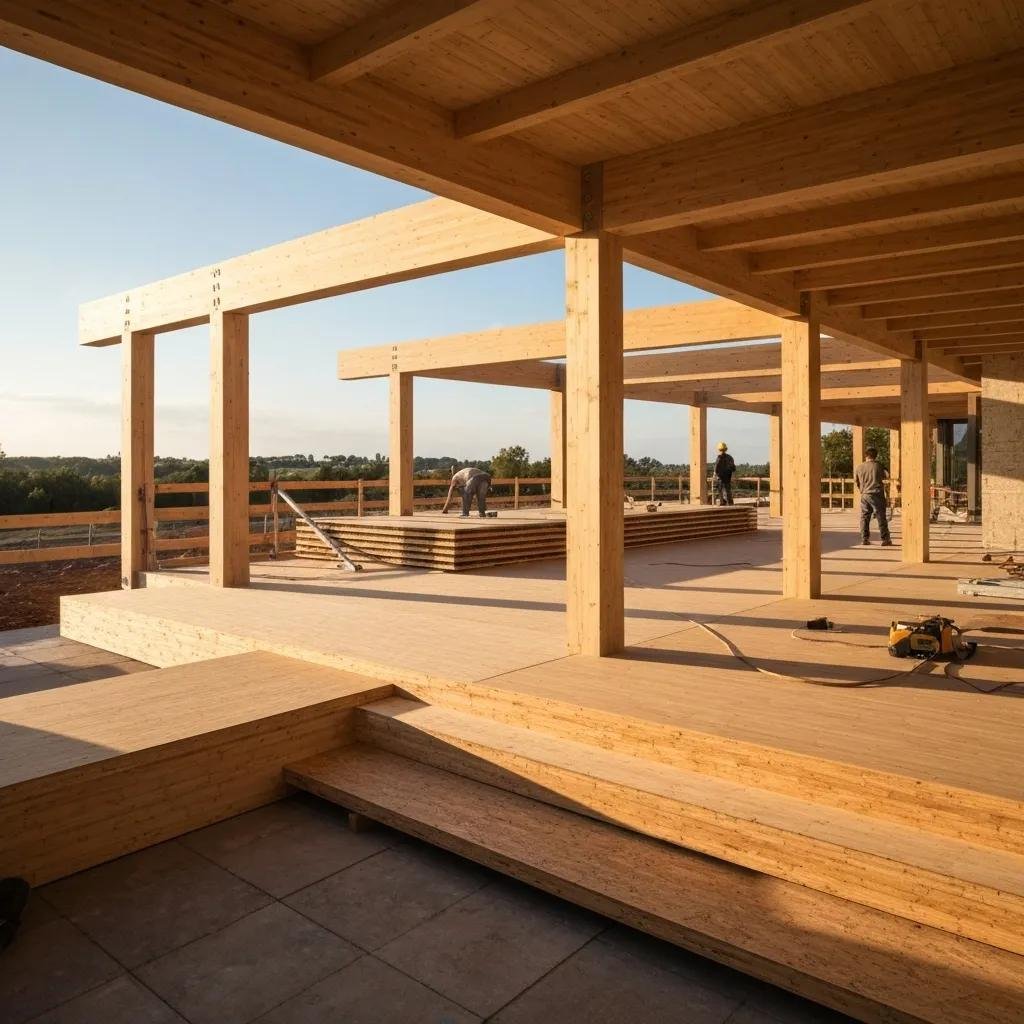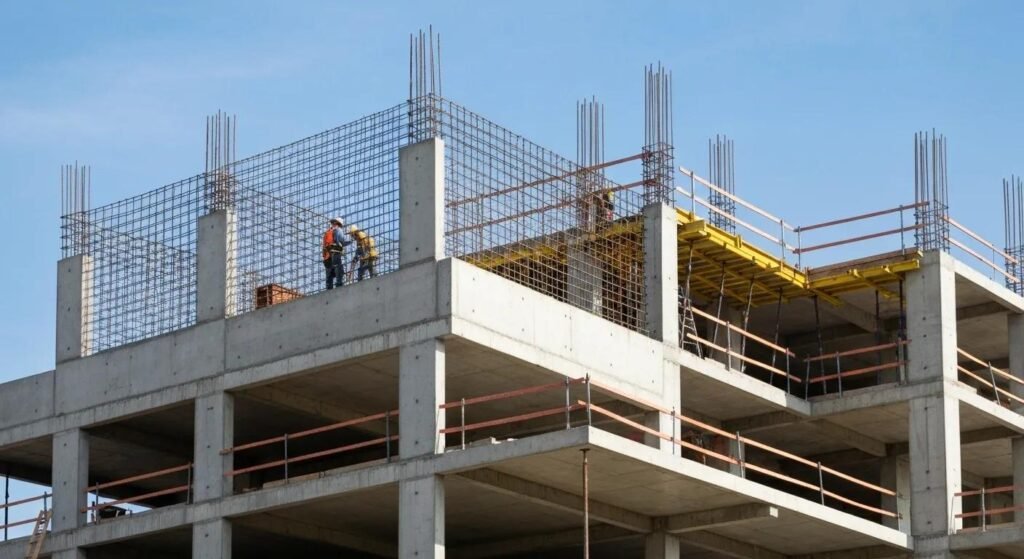Selecting Optimal Commercial Building Materials
Choosing the right quality materials for commercial projects determines long-term performance, maintenance demands, and environmental impact. Facility managers face budget pressures, evolving sustainability targets, and the need to minimize downtime—without compromising on structural integrity or indoor air quality. This guide reveals how durable concrete, steel, brick, and stone deliver longevity; explains the benefits of eco-friendly products like mass timber and low-VOC finishes; explores cutting-edge solutions such as self-healing concrete and smart glass; and highlights the role of professional cleaning—especially air duct cleaning—in protecting investments. Readers will learn to balance cost, compliance, aesthetics, maintenance, and digital marketing strategies to attract leads for commercial cleaning services.
What Are the Most Durable Commercial Construction Materials?
Material durability defines how well a structure resists wear, weathering, and fire over decades. Durable building materials minimize repair cycles and support predictable lifecycle costs while maintaining safety and appearance. Understanding relative longevity helps project teams select components that reduce operational interruptions and align with maintenance protocols.
Which Materials Offer the Best Longevity for Commercial Buildings?
Concrete, steel, brick, and natural stone each offer exceptional durability through distinct mechanisms. Concrete’s high compressive strength and low permeability resist environmental stressors and freeze-thaw cycles, promoting structural stability.
Durability of Concrete in Construction
Concrete’s compressive strength and resistance to environmental factors contribute to its long lifespan in commercial buildings, minimizing the need for frequent repairs and replacements. Research indicates that concrete’s durability is significantly influenced by factors such as the quality of materials, proper mixing, and adequate curing processes.
Kosmatka, S. H., Kerkhoff, B., & Panarese, W. C., Design and Control of Concrete Mixtures (Portland Cement Association, 2002)
This citation supports the article’s claims about concrete’s durability and its role in reducing long-term maintenance costs.
Steel’s tensile strength and fireproof coatings enable robust framing and seismic resilience. Brick combines thermal mass with moisture resistance to maintain stable interior climates. Stone’s inherent hardness and non-combustible nature protect facades and load-bearing elements for centuries. Selecting among these materials involves evaluating site conditions, structural requirements, and maintenance strategies—paving the way to a detailed strength and fire-resistance comparison.
How Do Concrete, Steel, Brick, and Stone Compare in Strength and Fire Resistance?

Below is a comparison of key properties that influence building performance and safety.
| Material | Structural Strength | Fire Resistance |
|---|---|---|
| Concrete | Compressive strength 3,000–5,000 psi | Non-combustible; 2–4 hours fire rating |
| Steel | Tensile strength 50,000–100,000 psi | Requires fireproofing for 1–2 hours |
| Brick | Compressive strength 3,000–10,000 psi | Naturally fire-resistant; 4+ hours |
| Stone | Compressive strength 5,000–30,000 psi | Inert in fire conditions |
Concrete and brick offer reliable passive fire control, while steel needs protective coatings to maintain integrity under extreme heat. Stone excels in both strength and flame resistance, making it ideal for critical façades.
Fire Resistance of Building Materials
The fire resistance of building materials is a critical factor in ensuring safety and minimizing damage in commercial structures. Studies show that materials like concrete and brick offer inherent fire resistance, while steel requires protective coatings to meet fire safety standards.
National Fire Protection Association, Fire Resistance Directory (2024)
This citation provides evidence for the article’s discussion on the fire-resistant properties of different construction materials.
Understanding these attributes leads seamlessly into where each material is best applied.
What Are the Common Applications of Durable Materials in Commercial Projects?
Commercial projects leverage the strength and resilience of durable materials across multiple components. Typical uses include:
- Foundations and load-bearing walls for maximum stability.
- Structural framing and columns to support high live loads.
- Exterior cladding and façades for weather protection.
- Heavy-traffic flooring in lobbies, corridors, and warehouses.
- Fire-rated partitions and stairwells to enhance life-safety.
Each application demands specific standards—such as ANSI standards for concrete mixes or ASTM fire-resistance criteria—that guide material selection and preparation for cleaning and maintenance workflows.
How Does Material Durability Impact Long-Term Maintenance Costs?
Durable materials reduce repair frequency, lower labor expenses, and preserve asset value through:
- Fewer structural inspections and reinforcements
- Extended intervals between surface recoating and sealing
- Reduced need for emergency patching or component replacement
By minimizing downtime and simplifying cleaning protocols, project owners can forecast operating budgets more accurately and allocate resources toward preventive commercial cleaning and air duct maintenance.
How Do Sustainable Commercial Building Materials Benefit Your Project?
Sustainable building materials integrate environmental stewardship with energy efficiency and occupant health. Eco-friendly products reduce carbon emissions, improve indoor air quality, and often qualify for green building certifications—unlocking financial incentives and enhancing corporate reputations while supporting long-term cost savings.
What Are the Top Eco-Friendly Materials for Commercial Construction?
- Cross-Laminated Timber (CLT) panels that sequester carbon and accelerate build schedules.
- Recycled steel, which diverts scrap from landfills and reduces embodied energy.
- Bamboo flooring, offering rapid renewability and robust durability.
- Recycled concrete aggregates, minimizing quarry impacts and lowering material costs.
- Low-VOC paints and coatings that limit off-gassing for healthier interiors.
These options support multiple sustainability goals, from energy-use reduction to LEED credits, while maintaining performance standards required in commercial settings.
How Do Low-VOC and Recycled Materials Improve Indoor Air Quality?
Low-VOC products reduce formaldehyde and chemical off-gassing that can trigger headaches and respiratory irritation. Recycled aggregates and wood composites often lack toxins found in virgin materials. Together, they promote cleaner ventilation air and reduce airborne contaminants—complementing regular air duct cleaning services to safeguard occupant health.
What Are the Environmental and Cost Benefits of Using Sustainable Materials?

Sustainable materials deliver a dual advantage:
- Lower carbon footprint through reduced extraction and manufacturing emissions.
- Potential energy-efficiency gains via enhanced thermal performance and daylighting.
- Lifecycle cost savings from decreased utility bills and maintenance cycles.
Sustainable Materials and Lifecycle Costs
The use of sustainable materials in commercial construction can lead to significant lifecycle cost savings through reduced energy consumption and lower maintenance requirements. Research demonstrates that eco-friendly materials often have a lower environmental impact and can contribute to achieving green building certifications, potentially unlocking financial incentives.
U.S. Green Building Council, LEED v4 Reference Guide (2013)
This citation supports the article’s claims about the benefits of sustainable materials, including cost savings and environmental advantages.
Organizations frequently realize ROI within project lifespans by combining reduced operational expenses with incentives such as tax credits and green financing.
How Do Green Building Certifications Influence Material Selection?
Certification systems like LEED, WELL, and BREEAM set thresholds for recycled content, indoor-air quality, and renewable resource use. Achieving certification guides architects to select compliant materials and aligns project teams with rigorous performance metrics—ensuring that eco-friendly choices also meet quality and safety standards.
What Innovative Commercial Building Materials Are Shaping the Future?
Innovative materials harness technology and biology to enhance performance, resilience, and occupant experience. Self-healing concrete, smart glass, advanced composites, and 3D-printed components are revolutionizing how commercial structures adapt, repair, and interact with their environment.
Below is a snapshot of leading innovations transforming commercial construction:
| Material | Advanced Feature | Performance Impact |
|---|---|---|
| Self-Healing Concrete | Embedded microcapsules or bacteria | Automatic crack repair extends service life |
| Smart Glass | Electrochromic tint control | Dynamic glare reduction and energy savings |
| Advanced Composites | High-strength fiber reinforcements | Lightweight structural elements with fatigue resistance |
| 3D-Printed Building Units | Layered fabrication precision | Waste reduction and design complexity enabled |
| Biophilic Panels | Living moss or plant integration | Improved acoustics and occupant well-being |
This evolution in materials shapes maintenance regimes and cleaning protocols, setting the stage for how new surfaces and systems integrate with professional cleaning and HVAC care.
How Does Self-Healing Concrete Enhance Building Performance?
Self-healing concrete contains healing agents—such as bacteria or polymer capsules—that activate upon crack formation. These agents precipitate calcium carbonate or resin to seal fissures, preventing moisture ingress and preserving structural integrity. As a result, repair costs and downtime drop, enabling more sustainable lifecycle management.
What Role Does Cross-Laminated Timber (CLT) Play in Sustainable Construction?
CLT consists of layered timber boards bonded at right angles for exceptional dimensional stability and load-bearing capacity. It offers rapid prefabrication, reduces on-site waste, and locks carbon within building assemblies. CLT panels expedite construction schedules while meeting stringent fire and structural codes, making them ideal for mid-rise commercial projects.
How Are Smart Glass and Advanced Composites Used in Commercial Projects?
Smart glass adapts its opacity via electrochromic or thermochromic technologies, reducing glare and HVAC loads in real-time. Advanced composites—such as carbon-fiber-reinforced polymers—create lightweight façades and structural supports that resist corrosion and fatigue. Their low-maintenance profiles streamline cleaning procedures and enhance lifecycle performance.
What Are the Benefits of 3D-Printed and Biophilic Design Materials?
3D printing allows on-demand fabrication of complex geometries with minimal waste, integrating structural and aesthetic functions in a single element. Biophilic panels embed living plants or moss into wall systems, improving indoor comfort, air purification, and acoustics. These materials merge innovation with wellness, requiring specialized maintenance protocols that integrate professional cleaning services for optimal longevity.
How to Choose the Best Materials for Your Commercial Construction Project?
Material selection balances cost, performance, sustainability, aesthetics, and compliance. A structured approach evaluates each option against project-specific criteria—ensuring decisions align with corporate goals, regulatory requirements, and maintenance strategies, including cleaning frequency and HVAC upkeep.
What Factors Should Influence Your Material Selection?
Select materials based on:
- Budget constraints and total lifecycle cost projections.
- Structural and performance requirements for load-bearing and façade elements.
- Sustainability targets, such as carbon reduction and recycled content.
- Climate and regional weather patterns affecting material exposure.
- Maintenance and cleaning protocols, including surface durability and HVAC compatibility.
Prioritizing these criteria ensures comprehensive evaluation of both construction and operational needs.
How Do Cost, Durability, and Sustainability Balance in Material Choices?
Cost, durability, and sustainability often present trade-offs. High-performance composites may carry premium costs but yield lower maintenance and energy bills, while recycled products can reduce carbon footprint at marginal cost increases. Life-cycle cost analysis helps quantify these factors, guiding optimal investments that support both capital and operating budgets.
What Regulatory and Aesthetic Considerations Affect Material Decisions?
Building codes dictate fire ratings, structural performance, and accessibility requirements. Aesthetic guidelines and local design review standards influence façade treatments and finishes. Ensuring compliance with regulations like the International Building Code (IBC) and achieving desired architectural character require careful material vetting and sample testing.
How Can Lifecycle Cost Analysis Include Cleaning and Maintenance?
Incorporating cleaning and maintenance costs into lifecycle analysis involves:
- Estimating frequencies for surface cleaning, resealing, and HVAC duct servicing.
- Calculating labor, product, and downtime expenses over the asset’s lifespan.
- Comparing total costs across material options to identify best-value solutions.
This integrated approach reveals the true cost of ownership and underscores the value of professional commercial cleaning services.
How Do Quality Materials Affect Commercial Cleaning and Maintenance Needs?
Material surfaces influence cleaning frequency, methods, and product selection. Hard, smooth finishes simplify dirt removal, while porous or textured surfaces require specialized protocols. Understanding these relationships helps facility teams coordinate material installation with tailored cleaning services and regular air duct maintenance for optimal indoor air quality.
How Do Different Materials Influence Commercial Cleaning Protocols?
Commercial cleaning teams adjust protocols based on surface types:
- Polished concrete and sealed stone require neutral pH cleaners and scheduled resealing.
- Carpeted zones demand hot-water extraction or dry foam systems to remove particulate.
- Glass façades utilize squeegee systems and eco-friendly glass cleaners.
- Metal panels often need corrosion-inhibiting agents and microfiber cloths to preserve finishes.
Matching cleaning methods to material properties prevents damage and extends service intervals.
Why Is Air Duct Cleaning Essential for Buildings with Quality HVAC Materials?
Air duct cleaning removes dust, particulate, and microbial contaminants that accumulate on galvanized or polymer-lined ductwork. Clean ducts enhance HVAC efficiency, protect expensive coil coatings, and maintain high indoor air quality—directly linking material quality with system longevity and occupant comfort.
How Does Proper Cleaning Extend Material Longevity and Indoor Air Quality?
Regular cleaning eliminates abrasive particles and chemical residues that degrade surfaces and finishes. By preserving sealants and coatings, cleaning extends material life and reduces repair cycles. Concurrent air duct maintenance prevents airborne pollutants from depositing on interior finishes, safeguarding healthier environments.
What Cost Savings Result from Integrating Material Choice with Cleaning Services?
Choosing materials with smooth, non-porous finishes reduces cleaning labor and product usage by up to 30%. Pairing these selections with scheduled commercial cleaning and duct maintenance lowers total operating expenses, minimizes unplanned repairs, and enhances occupant satisfaction—translating quality materials into measurable financial benefits.
What Are the Key Considerations for Material Use in Different Commercial Building Types?
Building type dictates functional, aesthetic, and sanitary requirements. Office environments focus on acoustics and comfort; retail spaces prioritize visual appeal and foot-traffic resilience; industrial facilities need chemical and impact resistance; healthcare projects demand antimicrobial and low-VOC surfaces.
How Do Material Needs Vary Between Office, Retail, Industrial, and Healthcare Projects?
Material requirements align with use cases:
- Offices benefit from carpet tiles or acoustic panels to reduce noise.
- Retail environments use durable flooring like porcelain tile and impact-resistant wall panels.
- Industrial facilities require chemical-resistant epoxy coatings and reinforced steel framing.
- Healthcare spaces demand non-porous, easily disinfected surfaces such as vinyl flooring and solid-surface countertops.
These distinctions inform cleaning protocols, warranty specifications, and maintenance schedules.
What Durable and Sustainable Materials Are Best Suited for High-Traffic Commercial Spaces?
High-traffic areas demand materials that combine durability with eco-credentials:
- Polished concrete floors with recycled aggregate content.
- Porcelain or quarry tile rated for heavy loads.
- Recycled rubber flooring for impact absorption.
- High-performance powder-coated metal components.
These choices balance longevity, sustainability targets, and straightforward cleaning procedures.
How Do Regional Climate and Building Codes Influence Material Selection?
Climate factors—such as humidity, temperature extremes, and UV exposure—determine moisture management, thermal performance, and UV resistance requirements. Local building codes establish fire resistance, structural safety, and wind load criteria, shaping feasible material options. Understanding these local influences ensures compliance and performance optimization.
How Can Digital Marketing Help Promote Quality Materials and Cleaning Services for Commercial Projects?
Digital marketing bridges technical expertise with client acquisition by educating stakeholders on material benefits, demonstrating cleaning protocols, and generating local leads. Content marketing, local SEO, social media, and paid ads position commercial cleaning businesses as trusted partners in facility management.
How Does Content Marketing Educate Clients on Material and Cleaning Importance?
Blog articles, case studies, and white papers illustrate how material choices affect maintenance budgets and indoor air quality. Thought leadership pieces on topics like “Cleaning Concrete Polished Floors” or “Impact of Low-VOC Finishes on HVAC Load” build authority and guide decision-makers toward professional cleaning solutions.
What Role Does Local SEO Play in Generating Leads for Commercial Cleaning Services?
Optimizing location-based keywords—such as “commercial cleaning services near me” or “industrial air duct cleaning [city name]”—improves visibility in map packs and organic results. Local citations, Google Business Profile optimization, and service-area pages drive qualified traffic from facility managers seeking nearby experts.
How Can Social Media and Paid Ads Enhance Visibility for Cleaning Businesses?
Targeted LinkedIn campaigns reach facility managers, while Instagram and Facebook ads showcase before-and-after cleaning projects. Google Ads, retargeting, and display networks reinforce brand recognition. These tactics accelerate lead generation and enable precise ROI tracking for cleaning service investments.
Why Is Integrating Material and Cleaning Content Key to Building Trust and Authority?
Combining insights on quality construction materials with professional maintenance guidance demonstrates comprehensive industry expertise. This integrated approach reassures decision-makers that cleaning providers understand building science and can protect high-value assets—ultimately fostering long-term client relationships.
Quality materials form the backbone of durable, sustainable, and high-performance commercial buildings. Informed selection—from concrete and steel to mass timber and self-healing composites—impacts operational expenses, environmental goals, and occupant wellbeing. Integrating professional commercial cleaning and air duct maintenance further extends asset lifespans and ensures healthy indoor environments. Businesses ready to optimize their project lifecycle and generate local leads for cleaning services can partner with Mastodon Marketing’s specialized digital marketing solutions to showcase expertise, attract facility managers, and drive growth.





